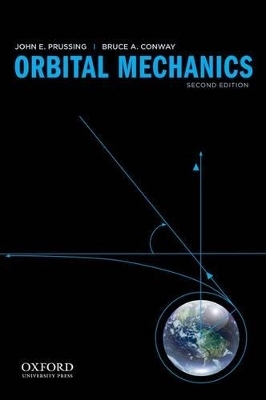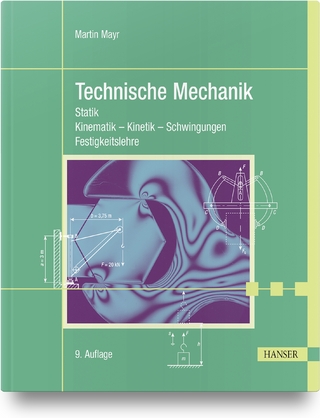
Orbital Mechanics
Oxford University Press Inc (Verlag)
978-0-19-983770-0 (ISBN)
Three new chapters: "The Three-Body Problem" (Ch. 4), "Continuous-Thrust Transfer" (Ch. 8), and "Canonical Systems and the Lagrange Equations" (Ch. 12)* New material on multiple-revolution Lambert solutions, gravity-assist applications, and the
state transition matrix for a general conic orbit* New examples and problems throughout* A new Companion Website with PowerPoint slides (www.oup.com/us/prussing)
John E. Prussing is Professor Emeritus of Aerospace Engineering at the University of Illinois at Urbana-Champaign. Bruce A. Conway is Professor of Aerospace Engineering at the University of Illinois at Urbana-Champaign.
Each Chapter ends with References and Problems.
Chapter 1: The n-Body Problem
1.1 Introduction
1.2 Equations of Motion for the n-Body Problem
1.3 Justification of the Two-Body Model
1.4 The Two-Body Problem
1.5 The Elliptic Orbit
1.6 Parabolic, Hyperbolic, and Rectilinear Orbits
1.7 Energy of the Orbit
Chapter 2: Position in Orbit as a Function of Time
2.1 Introduction
2.2 Position and Time in an Elliptic Orbit
2.3 Solution for the Eccentric Anomaly
2.4 The f and g Functions and Series
2.5 Position versus Time in Hyperbolic and Parabolic Orbits: Universal Variables
Chapter 3: The Orbit in Space
3.1 Introduction
3.2 The Orbital Elements
3.3 Determining the Orbital Elements from r and v
3.4 Velocity Hodographs
Chapter 4: The Three-Body Problem
4.1 Introduction
4.2 Stationary Solutions of the Three-Body Problem
4.3 The Circular Restricted Problem
4.4 Surfaces of Zero Velocity
4.5 Stability of the Equilibrium Points
4.6 Periodic Orbits in the Restricted Case
4.7 Invariant Manifolds
4.8 Special Solutions
Chapter 5: Lambert's Problem
5.1 Introduction
5.2 Transfer Orbits Between Specified Points
5.3 Lambert's Theorem
5.4 Properties of the Solutions to Lambert's Equation
5.5 The Terminal Velocity Vectors
5.6 Applications of Lambert's Equation
5.7 Multiple-Revolution Lambert Solutions
Chapter 6: Rocket Dynamics
6.1 Introduction
6.2 The Rocket Equation
6.3 Solution of the Rocket Equation in Field-Free Space
6.4 Solution of the Rocket Equation with External Forces
6.5 Rocket Payloads and Staging
6.6 Optimal Staging
Chapter 7: Impulsive Orbit Transfer
7.1 Introduction
7.2 The Impulsive Thrust Approximation
7.3 Two-Impulse Transfer Between Circular Orbits
7.4 The Hohmann Transfer
7.5 Coplanar Extensions of the Hohmann Transfer
7.6 Noncoplanar Extensions of the Hohmann Transfer
7.7 Conditions for Interception and Rendezvous
Chapter 8: Continuous-Thrust Transfer
8.1 Introduction
8.2 Equation of Motion
8.3 Propellant Consumption
8.4 Quasi-Circular Orbit Transfer
8.5 The Effects of Nonconstant Mass
8.6 Optimal Quasi-Circular Orbit Transfer
8.7 Constant-Radial-Thrust Acceleration
8.8 Shifted Circular Orbits
Chapter 9: Interplanetary Mission Analysis
9.1 Introduction
9.2 Sphere of Influence
9.3 Patched Conic Method
9.4 Velocity Change from Circular to Hyperbolic Orbit
9.5 Planetary Flyby (Gravity-Assist) Trajectories
9.6 Gravity-Assist Applications
Chapter 10: Linear Orbit Theory
10.1 Introduction
10.2 Linearization of the Equations of Motion
10.3 The Hill-Clohessy-Wiltshire (CW) Equations
10.4 The Solution of the CW Equations
10.5 Linear Impulsive Rendezvous
10.6 State Transition Matrix for a General Conic Orbit
Chapter 11: Perturbation
11.1 Introduction
11.2 The Perturbation Equations
11.3 Effect of Atmospheric Drag
11.4 Effect of Earth Oblateness
11.5 Effects of Solar-Lunar Attraction
11.6 Effect on the Orbit of the Moon
Chapter 12: Canonical Systems and the Lagrange Equations
12.1 Introduction
12.2 Hamilton's Equations
12.3 Canonical Transformations
12.4 Necessary and Sufficient Conditions for a Canonical Transformation
12.5 Generating Functions
12.6 Jacobi's Theorem
12.7 Canonical Equations for the Two-Body Problem
12.8 The Delaunay Variables
12.9 Average Effects of Earth Oblateness Using Delaunay Variables
12.10 Lagrange Equations
Chapter 13: Perturbations Due to Nonspherical Terms in the Earth's Potential
13.1 Introduction
13.2 Effect of the Zonal Harmonic Terms
13.3 Short-Period Variations
13.4 Long-Period Variations
13.5 Variations at O(J2/2)
13.6 The Potential in Terms of Conventional Elements
13.7 Variations Due to the Tesseral Harmonics
13.8 Resonance of a Near-Geostationary Orbit
Chapter 14: Orbit Determination
14.1 Introduction
14.2 Angles-Only Orbit Determination
14.3 Laplacian Initial Orbit Determination
14.4 Gaussian Initial Orbit Determination
14.5 Orbit Determination from Two Position Vectors
14.6 Differential Correction
Appendix 1: Astronomical Constants
Appendix 2: Physical Characteristics of the Planets
Appendix 3: Elements of the Planetary Orbits
Index
| Erscheint lt. Verlag | 26.12.2012 |
|---|---|
| Zusatzinfo | Illustrations, unspecified |
| Verlagsort | New York |
| Sprache | englisch |
| Gewicht | 605 g |
| Themenwelt | Naturwissenschaften ► Physik / Astronomie ► Mechanik |
| Technik ► Maschinenbau | |
| ISBN-10 | 0-19-983770-8 / 0199837708 |
| ISBN-13 | 978-0-19-983770-0 / 9780199837700 |
| Zustand | Neuware |
| Haben Sie eine Frage zum Produkt? |
aus dem Bereich


